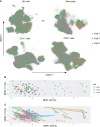Natural Killer Cell Receptors and Ligands Are Associated With Markers of HIV-1 Persistence in Chronically Infected ART Suppressed Patients
- PMID: 35223535
- PMCID: PMC8866573
- DOI: 10.3389/fcimb.2022.757846
Natural Killer Cell Receptors and Ligands Are Associated With Markers of HIV-1 Persistence in Chronically Infected ART Suppressed Patients
Abstract
The latent HIV-1 reservoir represents a major barrier to achieving a long-term antiretroviral therapy (ART)-free remission or cure for HIV-1. Natural Killer (NK) cells are innate immune cells that play a critical role in controlling viral infections and have been shown to be involved in preventing HIV-1 infection and, in those who are infected, delaying time to progression to AIDS. However, their role in limiting HIV-1 persistence on long term ART is still uncharacterized. To identify associations between markers of HIV-1 persistence and the NK cell receptor-ligand repertoire, we used twin mass cytometry panels to characterize the peripheral blood NK receptor-ligand repertoire in individuals with long-term antiretroviral suppression enrolled in the AIDS Clinical Trial Group A5321 study. At the time of testing, participants had been on ART for a median of 7 years, with virological suppression <50 copies/mL since at most 48 weeks on ART. We found that the NK cell receptor and ligand repertoires did not change across three longitudinal samples over one year-a median of 25 weeks and 50 weeks after the initial sampling. To determine the features of the receptor-ligand repertoire that associate with markers of HIV-1 persistence, we performed a LASSO normalized regression. This analysis revealed that the NK cell ligands CD58, HLA-B, and CRACC, as well as the killer cell immunoglobulin-like receptors (KIRs) KIR2DL1, KIR2DL3, and KIR2DS4 were robustly predictive of markers of HIV-1 persistence, as measured by total HIV-1 cell-associated DNA, HIV-1 cell-associated RNA, and single copy HIV-RNA assays. To characterize the roles of cell populations defined by multiple markers, we augmented the LASSO analysis with FlowSOM clustering. This analysis found that a less mature NK cell phenotype (CD16+CD56dimCD57-LILRB1-NKG2C-) was associated with lower HIV-1 cell associated DNA. Finally, we found that surface expression of HLA-Bw6 measured by CyTOF was associated with lower HIV-1 persistence. Genetic analysis revealed that this was driven by lower HIV-1 persistence in HLA-Bw4/6 heterozygotes. These findings suggest that there may be a role for NK cells in controlling HIV-1 persistence in individuals on long-term ART, which must be corroborated by future studies.
Keywords: HIV cure; HIV latency; human immunodeficiency virus (HIV); natural killer cell receptor ligands; natural killer cells.
Copyright © 2022 Ivison, Vendrame, Martínez-Colón, Ranganath, Vergara, Zhao, Martin, Bendall, Carrington, Cyktor, McMahon, Eron, Jones, Mellors, Bosch, Gandhi, Holmes, Blish and The ACTG 5321 Team.
Conflict of interest statement
The authors declare that the research was conducted in the absence of any commercial or financial relationships that could be construed as a potential conflict of interest.
Figures





Similar articles
-
The Black Book of Psychotropic Dosing and Monitoring.Psychopharmacol Bull. 2024 Jul 8;54(3):8-59. Psychopharmacol Bull. 2024. PMID: 38993656 Free PMC article. Review.
-
Structured treatment interruptions (STI) in chronic unsuppressed HIV infection in adults.Cochrane Database Syst Rev. 2006 Jul 19;2006(3):CD006148. doi: 10.1002/14651858.CD006148. Cochrane Database Syst Rev. 2006. PMID: 16856117 Free PMC article.
-
Antiretrovirals for reducing the risk of mother-to-child transmission of HIV infection.Cochrane Database Syst Rev. 2011 Jul 6;(7):CD003510. doi: 10.1002/14651858.CD003510.pub3. Cochrane Database Syst Rev. 2011. PMID: 21735394
-
Effectiveness of antiretroviral therapy in HIV-infected children under 2 years of age.Cochrane Database Syst Rev. 2012 Jul 11;(7):CD004772. doi: 10.1002/14651858.CD004772.pub3. Cochrane Database Syst Rev. 2012. Update in: Cochrane Database Syst Rev. 2014 May 22;(5):CD004772. doi: 10.1002/14651858.CD004772.pub4. PMID: 22786492 Updated.
-
Antiretrovirals for reducing the risk of mother-to-child transmission of HIV infection.Cochrane Database Syst Rev. 2007 Jan 24;(1):CD003510. doi: 10.1002/14651858.CD003510.pub2. Cochrane Database Syst Rev. 2007. Update in: Cochrane Database Syst Rev. 2011 Jul 06;(7):CD003510. doi: 10.1002/14651858.CD003510.pub3. PMID: 17253490 Updated.
Cited by
-
Small Molecule Targeting Immune Cells: A Novel Approach for Cancer Treatment.Biomedicines. 2023 Sep 24;11(10):2621. doi: 10.3390/biomedicines11102621. Biomedicines. 2023. PMID: 37892995 Free PMC article. Review.
-
From network biology to immunity: potential longitudinal biomarkers for targeting the network topology of the HIV reservoir.J Transl Med. 2025 Aug 13;23(1):906. doi: 10.1186/s12967-025-06919-z. J Transl Med. 2025. PMID: 40804634 Free PMC article. Review.
-
HIV-1 control in vivo is related to the number but not the fraction of infected cells with viral unspliced RNA.Proc Natl Acad Sci U S A. 2024 Sep 3;121(36):e2405210121. doi: 10.1073/pnas.2405210121. Epub 2024 Aug 27. Proc Natl Acad Sci U S A. 2024. PMID: 39190360 Free PMC article.
-
Advances in HIV Research Using Mass Cytometry.Curr HIV/AIDS Rep. 2023 Apr;20(2):76-85. doi: 10.1007/s11904-023-00649-x. Epub 2023 Jan 23. Curr HIV/AIDS Rep. 2023. PMID: 36689119 Free PMC article. Review.
-
No associations between HIV reservoir and inflammation in long-term virally suppressed dolutegravir-based ART-treated individuals.Front Immunol. 2025 Jul 28;16:1628086. doi: 10.3389/fimmu.2025.1628086. eCollection 2025. Front Immunol. 2025. PMID: 40791593 Free PMC article.
References
-
- Bache S. M., Wickham H. (2020). magrittr: A Forward-Pipe Operator for R. R package version 2.0.1. Available at: https://CRAN.R-project.org/package=magrittr.
Publication types
MeSH terms
Substances
Grants and funding
LinkOut - more resources
Full Text Sources
Medical
Research Materials

